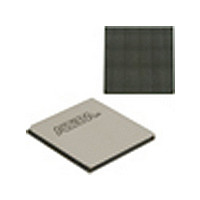EP4SGX530HH35C2N Altera, EP4SGX530HH35C2N Datasheet - Page 267

EP4SGX530HH35C2N
Manufacturer Part Number
EP4SGX530HH35C2N
Description
IC STRATIX IV FPGA 530K 1152HBGA
Manufacturer
Altera
Series
Stratix® IV GXr
Datasheets
1.EP4SGX110DF29C3N.pdf
(80 pages)
2.EP4SGX110DF29C3N.pdf
(1154 pages)
3.EP4SGX110DF29C3N.pdf
(432 pages)
4.EP4SGX110DF29C3N.pdf
(22 pages)
5.EP4SGX110DF29C3N.pdf
(30 pages)
6.EP4SGX110DF29C3N.pdf
(72 pages)
7.EP4SGX530HH35C2N.pdf
(1145 pages)
Specifications of EP4SGX530HH35C2N
Number Of Logic Elements/cells
531200
Number Of Labs/clbs
21248
Total Ram Bits
27376
Number Of I /o
564
Voltage - Supply
0.87 V ~ 0.93 V
Mounting Type
Surface Mount
Operating Temperature
0°C ~ 85°C
Package / Case
1152-HBGA
Family Name
Stratix® IV
Number Of Logic Blocks/elements
531200
# Registers
424960
# I/os (max)
560
Process Technology
40nm
Operating Supply Voltage (typ)
900mV
Logic Cells
531200
Ram Bits
28033024
Operating Supply Voltage (min)
0.87V
Operating Supply Voltage (max)
0.93V
Operating Temp Range
0C to 85C
Operating Temperature Classification
Commercial
Mounting
Surface Mount
Pin Count
1152
Package Type
FCHBGA
Lead Free Status / RoHS Status
Lead free / RoHS Compliant
Number Of Gates
-
Lead Free Status / Rohs Status
Compliant
Available stocks
Company
Part Number
Manufacturer
Quantity
Price
- EP4SGX110DF29C3N PDF datasheet
- EP4SGX110DF29C3N PDF datasheet #2
- EP4SGX110DF29C3N PDF datasheet #3
- EP4SGX110DF29C3N PDF datasheet #4
- EP4SGX110DF29C3N PDF datasheet #5
- EP4SGX110DF29C3N PDF datasheet #6
- EP4SGX530HH35C2N PDF datasheet #7
- Current page: 267 of 432
- Download datasheet (11Mb)
Chapter 7: External Memory Interfaces in Stratix IV Devices
Stratix IV External Memory Interface Features
February 2011 Altera Corporation
Leveling Circuitry
DDR3 SDRAM unbuffered modules use a fly-by clock distribution topology for better
signal integrity. This means that the CK/CK# signals arrive at each DDR3 SDRAM
device in the module at different times. The difference in arrival time between the first
DDR3 SDRAM device and the last device on the module can be as long as 1.6 ns.
Figure 7–27
Figure 7–27. DDR3 SDRAM Unbuffered Module Clock Topology
Because the data and read strobe signals are still point-to-point, take special care to
ensure that the timing relationship between the CK/CK# and DQS signals (tDQSS,
tDSS, and tDSH) during a write is met at every device on the modules. Furthermore,
read data coming back into the FPGA from the memory is also staggered in a similar
way.
Stratix IV FPGAs have leveling circuitry to address these two situations. There is one
leveling circuitry per I/O sub-bank (for example, I/O sub-bank 1A, 1B, and 1C each
has one leveling circuitry). These delay chains are PVT-compensated by the same DQS
delay settings as the DLL and DQS delay chains.
For frequencies equal to and above 400 MHz, the DLL uses eight delay chains, such
that each delay chain generates a 45° delay. The generated clock phases are
distributed to every DQS logic block that is available in the I/O sub-bank. The delay
chain taps then feeds a multiplexer controlled by the ALTMEMPHY megafunction to
select which clock phases are to be used for that ×4 or × 8 DQS group. Each group can
use a different tap output from the read-leveling and write-leveling delay chains to
compensate for the different CK/CK# delay going into each device on the module.
DQS/DQ
shows the clock topology in DDR3 SDRAM unbuffered modules.
DQS/DQ
DQS/DQ
DQS/DQ
CK/CK#
DQS/DQ
DQS/DQ
Stratix IV Device Handbook Volume 1
DQS/DQ
Stratix IV Device
DQS/DQ
7–47
Related parts for EP4SGX530HH35C2N
Image
Part Number
Description
Manufacturer
Datasheet
Request
R

Part Number:
Description:
CYCLONE II STARTER KIT EP2C20N
Manufacturer:
Altera
Datasheet:

Part Number:
Description:
CPLD, EP610 Family, ECMOS Process, 300 Gates, 16 Macro Cells, 16 Reg., 16 User I/Os, 5V Supply, 35 Speed Grade, 24DIP
Manufacturer:
Altera Corporation
Datasheet:

Part Number:
Description:
CPLD, EP610 Family, ECMOS Process, 300 Gates, 16 Macro Cells, 16 Reg., 16 User I/Os, 5V Supply, 15 Speed Grade, 24DIP
Manufacturer:
Altera Corporation
Datasheet:

Part Number:
Description:
Manufacturer:
Altera Corporation
Datasheet:

Part Number:
Description:
CPLD, EP610 Family, ECMOS Process, 300 Gates, 16 Macro Cells, 16 Reg., 16 User I/Os, 5V Supply, 30 Speed Grade, 24DIP
Manufacturer:
Altera Corporation
Datasheet:

Part Number:
Description:
High-performance, low-power erasable programmable logic devices with 8 macrocells, 10ns
Manufacturer:
Altera Corporation
Datasheet:

Part Number:
Description:
High-performance, low-power erasable programmable logic devices with 8 macrocells, 7ns
Manufacturer:
Altera Corporation
Datasheet:

Part Number:
Description:
Classic EPLD
Manufacturer:
Altera Corporation
Datasheet:

Part Number:
Description:
High-performance, low-power erasable programmable logic devices with 8 macrocells, 10ns
Manufacturer:
Altera Corporation
Datasheet:

Part Number:
Description:
Manufacturer:
Altera Corporation
Datasheet:

Part Number:
Description:
Manufacturer:
Altera Corporation
Datasheet:

Part Number:
Description:
Manufacturer:
Altera Corporation
Datasheet:

Part Number:
Description:
CPLD, EP610 Family, ECMOS Process, 300 Gates, 16 Macro Cells, 16 Reg., 16 User I/Os, 5V Supply, 25 Speed Grade, 24DIP
Manufacturer:
Altera Corporation
Datasheet:












